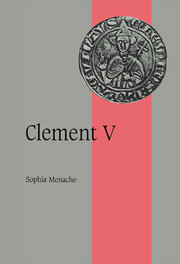7 - The Council of Vienne and the Clementinae
Published online by Cambridge University Press: 04 December 2009
Summary
W. A. Pantin has called attention to the fact that ‘the fourteenth century saw a remarkable combination of the centralisation of the Church on the one hand, with well-developed nationalism, on the other’. One of the most significant aspects of Clement's pontificate was the pope's genuine attempt to find a via media between different and often opposing interests. Clement was well aware of the limitations on the Church posed by the emergence of the national state. He tried – succeeding to a significant degree – to pave the road that the Church should take in a world undergoing an accelerated process of change that jeopardised ecclesiastical immunity. From this perspective, the legislation of Clement V should be appreciated as a very positive outcome only a few years after the outrage of Anagni. Although Clement V has often been criticised for his lack of initiative – John XXII being credited with the consolidation of the papal monarchy in the Avignon period – there was hardly an issue concerning the Church that escaped his attention. Clement analysed in depth the Church's fragile balance with the rulers of Christendom as well as the different facets of ecclesiastical life, both in the secular and monastic orders, and the ties between the exempt Orders and the secular clergy, the Spirituals and the Conventuals. The result in the form of a juridical document, the Clementinae, gives ample proof of the pope's legal skills. As the seventh book of the Decretals, the Clementinae complemented the legislative process that had begun in the thirteenth century, the classical era of canon law.
- Type
- Chapter
- Information
- Clement V , pp. 279 - 305Publisher: Cambridge University PressPrint publication year: 1998



